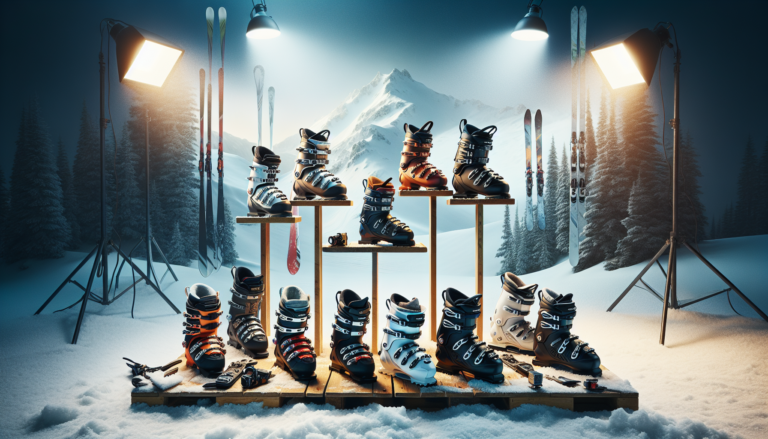When planning a ski trip, one of the key considerations is the weight of your ski equipment, particularly your ski boots. The weight of ski boots can vary significantly depending on the type, brand, and intended use. In this comprehensive guide, we’ll explore the factors that influence ski boot weight, compare different types of boots, and provide a helpful ski boot weight chart to aid in your decision-making process.
Introduction to Ski Boot Weights
Ski boots are an essential piece of equipment for any skier, providing the necessary support, control, and protection while on the slopes. However, the weight of ski boots can have a significant impact on your overall skiing experience, as well as your travel plans when flying to your ski destination.
Understanding the weight of different ski boots can help you make informed decisions about which boots to purchase or rent, and how to efficiently pack your ski gear for your next trip. In this article, we’ll delve into the world of ski boot weights, exploring the various factors that contribute to their weight and providing a comprehensive ski boot weight chart for easy comparison.
Why Ski Boot Weight Matters
The weight of your ski boots can affect several aspects of your skiing experience, including:
- Performance: Lighter boots often provide better agility and control, while heavier boots offer more stability and power transmission.
- Comfort: The weight of your boots can impact your overall comfort level, especially during longer skiing sessions or when hiking in backcountry terrain.
- Travel: Ski boot weight becomes a crucial factor when flying to your ski destination, as airlines have strict weight limits for checked and carry-on luggage.
By understanding the weight of different ski boots, you can make informed decisions that balance your performance needs, comfort preferences, and travel requirements.
Factors Influencing Ski Boot Weight
Several factors contribute to the overall weight of ski boots, including:
- Materials: The materials used in the construction of the boot, such as plastic, carbon fiber, or Grilamid®, can significantly impact its weight.
- Insulation: The amount and type of insulation used in the boot can add to its overall weight.
- Flex rating: Stiffer boots designed for advanced skiers often weigh more than softer, more flexible boots for beginners.
- Features: Additional features like walk modes, adjustable cuffs, or heat-moldable liners can increase the weight of the boot.
By considering these factors, you can better understand why certain ski boots may weigh more or less than others and make informed choices based on your specific needs and preferences.
Types of Ski Boots and Their Weights
Ski boots can be broadly categorized into two main types: alpine ski boots and backcountry ski boots. Each type has its own unique characteristics and weight ranges.
Alpine Ski Boots
Alpine ski boots are designed specifically for downhill skiing at resorts. They prioritize performance, control, and power transfer, often featuring stiffer flex ratings and more robust construction. As a result, alpine ski boots tend to be heavier than their backcountry counterparts.
The weight of alpine ski boots can vary depending on the specific model and size, but on average, a single alpine ski boot weighs between 1.6 to 2.2 kilograms (3.5 to 4.8 pounds). This means that a pair of alpine ski boots typically weighs between 3.2 to 4.4 kilograms (7 to 9.6 pounds).
Backcountry Ski Boots
Backcountry ski boots, also known as touring boots, are designed for skiers who venture beyond resort boundaries and into unmarked terrain. These boots prioritize lightweight construction and walkability, often featuring walk modes and pin-tech bindings compatibility.
Due to their focus on weight savings, backcountry ski boots are generally lighter than alpine boots. On average, a single backcountry ski boot weighs between 1.2 to 1.8 kilograms (2.6 to 4 pounds). This translates to a pair of backcountry boots weighing between 2.4 to 3.6 kilograms (5.2 to 8 pounds).
Ski Boot Weight Chart
To help you compare the weights of different ski boots, we’ve compiled a comprehensive ski boot weight chart featuring popular brands and models. This chart provides a quick reference for the average weight of both alpine and backcountry ski boots.
Weight Ranges for Different Brands
| Brand | Alpine Boot Weight (Single) | Backcountry Boot Weight (Single) |
|---|---|---|
| Atomic | 1.7 – 2.1 kg (3.7 – 4.6 lbs) | 1.3 – 1.7 kg (2.9 – 3.7 lbs) |
| Dalbello | 1.6 – 2.0 kg (3.5 – 4.4 lbs) | 1.2 – 1.6 kg (2.6 – 3.5 lbs) |
| Fischer | 1.8 – 2.2 kg (4.0 – 4.8 lbs) | 1.4 – 1.8 kg (3.1 – 4.0 lbs) |
| Nordica | 1.7 – 2.1 kg (3.7 – 4.6 lbs) | 1.3 – 1.7 kg (2.9 – 3.7 lbs) |
| Rossignol | 1.6 – 2.0 kg (3.5 – 4.4 lbs) | 1.2 – 1.6 kg (2.6 – 3.5 lbs) |
| Salomon | 1.7 – 2.1 kg (3.7 – 4.6 lbs) | 1.3 – 1.7 kg (2.9 – 3.7 lbs) |
Please note that these weights are averages and can vary based on the specific model, size, and features of the boot. Always refer to the manufacturer’s specifications for the most accurate weight information.
Visual Representation of Ski Boot Weights
To better visualize the weight differences between alpine and backcountry ski boots, consider this comparison:
- A pair of alpine ski boots is roughly equivalent to carrying a gallon of milk in each hand.
- A pair of backcountry ski boots is similar to holding a half-gallon of milk in each hand.
While these comparisons are not exact, they provide a relatable reference point for understanding the weight differences between the two types of ski boots.
Ski Boot Weight and Travel Considerations
When planning a ski trip that involves air travel, the weight of your ski boots becomes a crucial factor to consider. Airlines have strict weight limits for both checked and carry-on luggage, and exceeding these limits can result in additional fees or the need to leave items behind.
Managing Ski Boot Weight for Air Travel
To minimize the impact of ski boot weight on your travel plans, consider the following tips:
- Wear your boots: Many skiers choose to wear their ski boots on the plane to avoid adding their weight to checked luggage.
- Use a boot bag: Invest in a dedicated ski boot bag that fits within carry-on size limits. This allows you to keep your boots with you and avoid checked baggage fees.
- Rent boots at your destination: If you’re traveling to a popular ski resort, consider renting boots instead of bringing your own. This eliminates the need to transport heavy boots altogether.
By strategically managing the weight of your ski boots, you can reduce the overall weight of your luggage and minimize the risk of incurring additional fees or complications during air travel.
Tips for Packing Ski Boots
When packing your ski boots for travel, keep these tips in mind:
- Use boot bags with padding: Opt for a boot bag with ample padding to protect your boots during transit.
- Stuff socks inside boots: Place your ski socks inside your boots to save space and keep them organized.
- Secure buckles and straps: Fasten all buckles and straps on your boots to prevent them from catching on other items in your luggage.
- Distribute weight evenly: If packing boots in checked luggage, place them in the center of your bag and surround them with softer items to balance the weight distribution.
By following these packing tips, you can ensure that your ski boots are well-protected and efficiently packed for your travels.
Choosing the Right Ski Boots Based on Weight
When selecting ski boots, it’s essential to consider weight alongside other crucial factors like fit, flex, and intended use. While lighter boots may seem appealing for their ease of movement and reduced fatigue, it’s important to strike a balance between weight and performance.
Balancing Weight and Performance
Consider your skiing style, ability level, and the type of terrain you’ll be tackling when weighing the importance of boot weight.
- Beginner to intermediate skiers: Lighter boots with softer flex ratings may be more forgiving and comfortable, allowing for easier progress and less fatigue.
- Advanced to expert skiers: Heavier, stiffer boots provide the necessary support, power transfer, and precision for tackling challenging terrain and high speeds.
- Backcountry skiers: Lightweight boots with walk modes are essential for efficient uphill travel and reduced energy expenditure during long tours.
Ultimately, the right balance of weight and performance will depend on your individual needs and preferences as a skier.
Popular Ski Boot Brands and Their Offerings
Many well-known ski boot brands offer a range of options to suit different skiing styles, ability levels, and weight preferences. Some popular brands to consider include:
- Atomic: Known for their high-performance boots, Atomic offers both lightweight and more substantial options for all skiing levels.
- Dalbello: Dalbello specializes in ski boots and provides a wide range of models, from lightweight touring boots to sturdy alpine boots.
- Fischer: Fischer offers a selection of high-quality boots, including lightweight touring models and performance-oriented alpine boots.
- Nordica: Nordica is renowned for their innovative boot designs, catering to skiers of all abilities with various weight options.
- Rossignol: Rossignol produces a diverse lineup of ski boots, from lightweight backcountry models to robust alpine boots for demanding terrain.
- Salomon: Salomon offers a range of boots designed for different skiing disciplines, with a focus on performance and weight savings.
When choosing a ski boot brand, consider their reputation, the range of models they offer, and read reviews from other skiers to gauge the boots’ performance and weight characteristics.
Conclusion
Understanding the weight of ski boots is a crucial aspect of selecting the right gear for your needs and ensuring a smooth travel experience. By considering factors like boot type, materials, and features, you can make informed decisions that balance weight, performance, and comfort.
Use the ski boot weight chart provided in this guide as a helpful reference when comparing different brands and models. Remember to prioritize fit and intended use alongside weight considerations, as the right boot for you will depend on your individual skiing style and goals.
Key Takeaways
- Ski boot weight varies based on factors like boot type, materials, flex rating, and features.
- Alpine ski boots are generally heavier than backcountry ski boots, prioritizing downhill performance over weight savings.
- When traveling with ski boots, consider wearing them on the plane, using a boot bag, or renting at your destination to manage luggage weight.
- Strike a balance between weight and performance when selecting ski boots, considering your skiing ability, style, and intended terrain.
- Consult the ski boot weight chart and explore offerings from popular brands to find the best options for your needs.
Armed with this knowledge, you can confidently navigate the world of ski boot weights and make informed decisions that enhance your overall skiing experience. Happy skiing!






